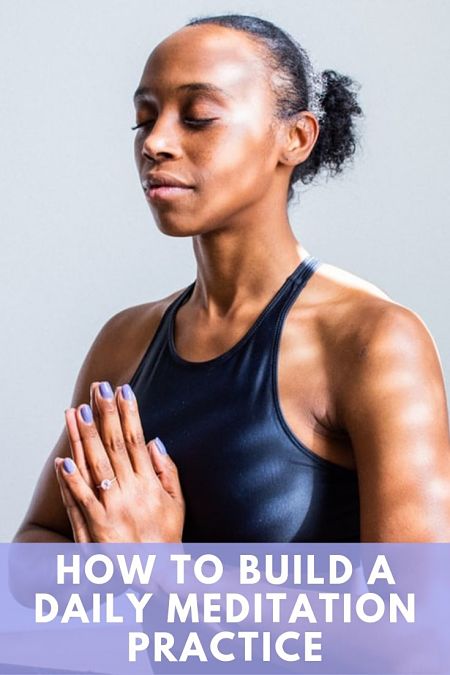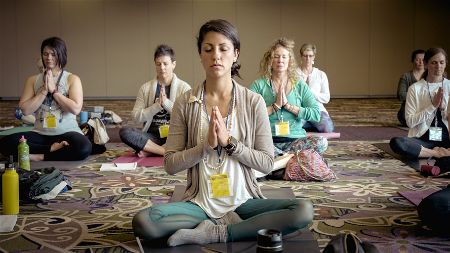Meditation is an activity that has positive health benefits, both mental and physical. It can be used to assist nearly everything from lowering blood pressure to calming anxiety to aiding in sleep.
The secret ingredient, if you will, is that meditation focuses on breathing. A focus on breathing can produce a variety of mental states, most of them very positive. They can help provide different understandings, perspectives, clarity, calm, and peace.
While identifying the benefits of meditation is easy, building up to a regular, daily meditation practice is quite difficult. This article looks at how to meditate daily, and focuses on tips and strategies to help make meditating part of your daily routine.

Unlocking the Benefits of Meditation
Meditation isn’t an activity in which you can invest two or three hours on the weekend and have stored up for the week. You can’t “bank” your meditation time, and withdraw it from the medit-ATM when you need it.
Most meditation sessions last from ten to thirty minutes. Some people find that they gain benefits from just meditating for two or three minutes. As you begin meditating regularly, you can work to identify the length of time that is right for your needs. Personally, I find that I need more than 10 minutes of uninterrupted meditation time to get much out of it.
The key to gaining the greatest benefits of meditation is to do it regularly. Of course, our modern lives make it difficult to do almost anything personal on a regular basis.
Building habits is hard!
The good news is that meditation is easy. It doesn’t require any tools, books, music or even a mat (though you may benefit from some of these things).
You can meditate almost anywhere, at almost any time. You can increase your mental and physical health by meditating as little as two or three minutes per day, though targeting a longer time-frame is usually wise.
Find a quiet, safe place where you are comfortable and unlikely to be interrupted. It is also wise to avoid meditating when operating machinery unless you are sufficiently advanced in your meditation practice to use it as a means of focusing on the task at hand.
Take a Deep Breath. Now Repeat.

Sit comfortably with your spine as straight as you can manage. Imagine a string extending from the top of your head to the ceiling. If you are physically unable to sit erect, you can lie down to meditate or make yourself as comfortable as you can in whatever position is required. If you need a meditation bolster or zafu/zabuton set, these may help your comfort level.
Your goal is for enough comfort that you’re not thinking too much about your body, but not so much comfort that you fall asleep.
Think about your breathing. Breath in slowly for a count of five, hold your breath for a count of five, breath out slowly for a count of five, then hold the lungs empty for a count of five. Do this two or three times, then take a deep breath through your nose and blow out forcefully through your mouth.
If your mind wanders away from your breathing, acknowledge that it has wandered, then refocus on your breath. Consider each identification of wandering to be a small victory, and gently bring the focus back to the breath. This is key: you don’t want to beat yourself up for mind wandering. Instead, you want to congratulate yourself for finding your way back.
If you need to be aware of time passing, it is nice to have a meditation timer that will play a soft chime when it is time to move to your next activity. You can use a timer on your phone, but just be sure to place your phone somewhere that you won’t be tempted to grab it while meditating.
Developing Regular Meditation Practice
You can, of course, just sit down and get started meditating. This simple activity doesn’t really require planning. But if you hope to make it a regular habit (and that really is the best) you might want to think about your usual day. Consider your work schedule, your household chores, pet, child, spouse or parent care.
Meditation should be a means of helping you make it through your regular day, not a replacement for necessary daily activities.
With this in mind, you might seek a time in your daily routine when you could incorporate some meditation time into your regular schedule. Here are some ideas for good times to meditate:
- Get up fifteen minutes early, preferably before the rest of your family is awake.
- In the bath/shower
- After the children go to school/spouse goes to work
- On your lunch break (if there is a quiet, private place)
- At the gym
- At yoga class
- In a chapel
- While washing dishes
- After the family has gone to bed
For many people, it isn’t so much a matter of finding several minutes of time to meditate, but rather it’s a matter of finding a string of 15 or so minutes of uninterrupted time to devote to meditation.
One single parent routinely paid her sitter for an extra half-hour each day. She used that thirty minutes to pull her car into a shady parking lot and to meditate, write poetry, and just let the stresses of the day roll off her before picking up her child.
Try two or three different times of day for your regular meditation practice. Find times that work, and try to identify the best times for your schedule.
Add the meditation it to your calendar, your day runner, or whatever you use to keep track of appointments. Make it an appointment with yourself, a regular activity that you undertake just as you might brushing your teeth or any other personal grooming.
In fact, that is a good way to think of your meditation practice: consider it mental grooming, rather like combing your hair or using dental floss. It is not dissimilar. Meditation is a way of calming your thoughts, letting you “get it together” and focus on whatever needs to happen.
And if you think it would be too difficult to devote 15 minutes or more every day to sitting, you may want to consider how you could work some alternative meditation methods into your schedule as well.
Alternative Meditation Methods

Some people find just sitting and focusing on your breathing to be incredibly difficult. Some alternative methods of meditation include:
- Using a focus point, such as a candle flame, a point on the wall, or a non-representational picture
- Focusing on a sound, song, or mantra
- Walking while focusing on connecting your footsteps with breathing
- Running while focusing on timing your footsteps with breathing
- Cycling while keeping your breathing in rhythm with your pedaling
- An exercise program such as Yoga or Tai Chi that incorporates breathing and exercise
In each case, focus on breath and breathing is an important part of meditation. But the most important part is selecting an activity or method that you can practice each day for a specific amount of time.
Simply scheduling 15 minutes to go for a meditative walk or run is great for the body and soul, and for many people feels much less daunting than sitting on the pillow, eyes closed, for 15 minutes or more!
Group meditation classes and yoga classes are an outstanding solution for incorporating meditation into your day. If you can schedule a couple of yoga classes each week, most yoga classes will have a meditation portion of the class. And a couple of yoga classes per week will certainly be a good thing for your overall health!
How to Meditate Daily: Building the Habit
Meditation is an easy activity. It does not require props, special equipment, special clothing, a book or an instructor. It isn’t even difficult, even though some instructions might make it seem as if it might be difficult. The hard part is sticking to it, and making it a part of your life in an ongoing manner.
Here are the simple steps for how to meditate daily.
- Find a meditation method that suits you. This might be the method outlined above, or one of the many apps or books that guide you on meditation. My favorite is The Mind Illuminated by John Yates, Ph.D.
- Select a safe, quiet, private place to meditate. This might be your bedroom, your bathroom, the lunch or break room at work, a local chapel, or even a park if it is in a secure location.
- Select a time of day that will allow you to take at least a few minutes for yourself. This might be a time before the family wakes, after they go to their schools or jobs, or anyplace where you can stop and feel comfortable centering on yourself.
- Schedule the time. Mark it on your calendar, in your day planner or make a mental note.
- Practice your meditation at the selected time each day, if possible.
- If circumstances prevent meditating at your usual time, tuck a few minutes into another part of you schedule or (as sometimes is needed if your day is tumultuous) retreat to a quiet place and use a little private time to meditate and sort your emotions into something manageable.
- Avoid becoming dependent on physical items for your meditation practice because these can make it difficult to meditate when you need those emergency mental sorting times. This is especially true of technology, including meditation apps. They’re great, but they come with some inherent distraction issues.
- Don’t panic if you miss a day. It happens.
- After a missed day, examine why you missed that session and make any scheduling adjustments needed to get your routine going again.
- Never give up. All you need to meditate is you, your breath, and a quiet place.
Using Apps and Technology for Meditation Scheduling
Many meditation apps “gamify” meditation, giving you badges for multi-day meditation streaks and the like. I’m of two minds on this method: yes, it does give some incentive to keep the meditation practice up, but it also incorporates technology into the meditation process.
Technology is an ever-present draw for most all of us. Many find that simply by having their phone nearby, the phone becomes a distraction and a barrier to meditating. The temptation is always there. Even when the phone is not in use!
Removing the phone and technology from the practice of meditation can be quite freeing, more enjoyable, and easier to keep up. Many find a 15-30 minute respite from the temptations of technology to be strongly beneficial.
Use a meditation app to get started and comfortable with your meditation practice. But as soon as possible, transition away from these systems.
A Classical Reference

In the original book Peter and Wendy by J.M. Barrie, the author describes Mrs. Darling, Wendy’s mother, as developing a little ritual of going through her children’s minds and organizing them after they are asleep. He describes how she sorts through their thoughts and plays from the day, sorting them into appropriate drawers and putting the best thoughts out on top for them to discover the following morning.
Fortunately, mothers are not capable of doing this sort of sorting through children’s minds. But it is an excellent visualization that we, as adults, can use during more advanced meditation. You can imagine tucking troublesome thoughts away in a drawer while selecting better thoughts on top.
Or, if a troublesome thought is something that truly needs attention, you can imagine ways to mend it, scrub out the stains, or to even determine if some real-world action needs to take place to put it to rest.
Breathing as Focus
Not all thoughts yield readily to mental sorting. It is not always easy to bring along a picture or other aid to help you get into your meditation. Sometimes your thoughts can become so agitated that trying to sort them into their proper drawers seems a nearly hopeless task.
But your breath is always with you. It is essential for your ability to live.
Focusing on it, keeping it steady, regular, and controlled helps you to steady and control your thoughts. This ability to focus on your breathing and use meditation to calm yourself takes practice. Practice will help you develop meditation as a habit that will allow you to set aside troubling or scary thoughts and to be able to focus on the things that really need to happen.
Some Parting Thoughts
Here are a few parting thoughts. Meditation has been practiced for centuries. It is used by a variety of religions, but it is often practiced by those who have no religion at all. It does not require belief in anyone or anything. While you can bring your faith or belief into meditation, it is really just about allowing your body to relax, your mind to still, and you to be able to take care of the essential things that are part of your daily life.
It isn’t rocket science. Although many rocket scientists can, no doubt, benefit from some quiet time.
Meditation is the means to still the chattering, noisy part of one’s mind, acknowledge fears, sorrows and even anger, and to clear the decks for productive thoughts that can lead to fixing the things that can be fixed, accepting those that cannot, and embracing life as it is – not necessarily as we want it to be.
Good luck building the practice into your daily routine and making meditation a permanent part of your life.






